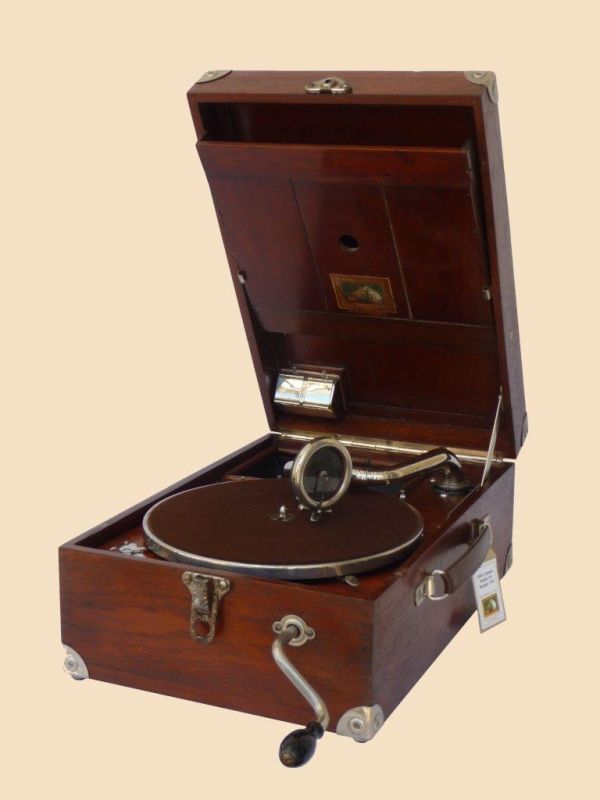HMV Portable Gramophone Model 101 Teak
MANUFACTURER: Gramophone Company of India Ltd., Calcutta
MODEL: Portable model 101
SERIAL NO.:
YEAR: ca. 1925-1931
PRICE: unknown
CASE: Highly polished Teak oak finish
TURNTABLE: 10 in./ 25 cm
HORN: internal, zinc-folded
MOTOR: HMV 400 series
SOUNDOX: HMV No. 4
 The Gramophone Company of India Ltd. (a branch of the British Gramophone Company Ltd.), headquartered in Dum Dum, Calcutta, was founded about 1908 and produced phonographs and records for the Indian market. Buyers were primarily the British colonial rulers and wealthy Indians.
The Gramophone Company of India Ltd. (a branch of the British Gramophone Company Ltd.), headquartered in Dum Dum, Calcutta, was founded about 1908 and produced phonographs and records for the Indian market. Buyers were primarily the British colonial rulers and wealthy Indians.Characteristic for models of the indian market or production is the case that was usually made of teak and mahogany sporadically. Teak because it is very durable and weather-resistant and sensitive to environmental influences. It convinces with high strength and hardness.
The surface is a "high polished", which actually corresponds contrary to the usual "satin finish" on mahogany-machines with a pore-filled and high-glossy surface.
Most machines that turns up had a variable history. Many machines reached England with the former owners (British colonialists, the so-called Raj) during their return from India. That´s the reason why one finds these relatively rare models in England and occasionally in Holland.
Whether horn-, tablemodels, cabinet grands or portable gramophones - many models that belong to the standard range of the Gramophone Company in England or were produced in factories in Hayes, were also available in India. In addition, there are a few models that existed only in India or were there produced and sold by the Gramophone Company of India.
The model shown below is a kind of a special version of the portable model 101 for the Indian and colonial market. The case and all the parts that were Rexine-covered in the conventional model, are made here in solid teak.
From the parts and front-wind-motor used on this model it corresponds to european model 101, as it was made in 1925. As with the "standard" 101 there are different types of the indian model 101.

Die Gramophone Company of India Ltd. (eine Tochter der britischen Gramophone company Ltd.) mit Sitz in Dum Dum, Calcutta, wurde ca. 1908 gegründet und produzierte Grammophone und Platten für den indischen Markt. Als Käufer kamen primär die britsichen Kolonialherren sowie wohlhabende Inder in Frage.
Charakteristisch für Geräte für den indischen Markt bzw. aus indischer Produktion ist, dass die Gehäuse in der Regel aus Teakholz und vereinzelt auch aus Mahagoni gefertigt wurden. Teak erklärt sich darin, dass Teakholz sehr robust und witterungsbeständig sowie unempfindlich gegen Umwelteinflüsse ist. Es verzieht sich auch bei wechselndem Klima kaum und überzeugt durch eine hohe Festigkeit und Härte. Die Oberfläche ist ein "high polished", was entgegen dem üblichen "Satin finish" tatsächlich einer porengefüllten und hochglänzenden Oberfläche entspricht.
Zumeist haben die Geräte eine wechselhafte Geschichte hinter sich. Viele Geräte sind mit den damaligen Besitzern (britischen Kolonialherren, die sog. Raj) von Indien nach England gelangt, weswegen man heute diese vglw. raren Modelle in England und vereinzelt in Holland vorfindet.
Egal ob Trichtergerät, Stand- oder Tischgerät oder Koffergrammophon - viele Modelle, die zum Standard-Sortiment der Gramophone Company in England gehören bzw. in den Fabriken in Hayes produziert wurden, waren auch in Indien erhältlich. Darüber hinaus gibt es einige wenige Modelle, die es ausschließlich in Indien gab bzw. dort durch die Gramophone Company of India produziert und vermarktet wurden.
Bei dem hier gezeigten Gerät handelt es sich um eine Art Sonderausführung des Koffermodells 101 für den indischen bzw. Kolonialmarkt. Der Koffer und alle Teile die beim konventionellen Modell mit Leder/Kunstleder bezogen waren, sind hier aus massivem Teakholz gemacht.
Von der Ausstattung und dem Frontaufzug entspricht es einem Modell 101, wie es um 1925 hergestellt wurde. Wie auch beim europäischen "Standard"-101 findet man auch das in Indien gefertigte 101 in den unterschiedlichsten Ausstattungsvarianten.
The first version of the Model 101 doesn´t has any autobreak. The winding handle clips on the front wind-101s were not well postioned and it´s unusual to find all three complete.
The machine is fitted with the first version of the HMV No. 4 soundbox (with the lettering behind the mica). Furthermore it has the needle container on the left side of the lid. It is the same like the model 100 has, but on the 100 it is located on the right side.

The winding handle on the front-wind-101s was not well positioned. To wind up the motor, the machine always had to stand on a table edge. This was changed with the introduction of the side-winding motor.
WRITTEN BY: The Symbol of Supremacy
Über Uns
Wir sind mehr als ein Forum! Als eingetragener Verein arbeiten wir an der Beständigkeit unserer Leidenschaft.
Über unsWir suchen Dich!
Du schreibst Artikel, möchtest im Forum als Moderator aktiv werden? Dir liegt Social Media. Bewahre Wissen! Wir warten auf dich.
Schreib unsTipps
Einsteiger-Ratschläge für optimale Nutzung und wichtige Aspekte beim Grammophon und Schellackplatten-Kauf.
Zu den Informationen




